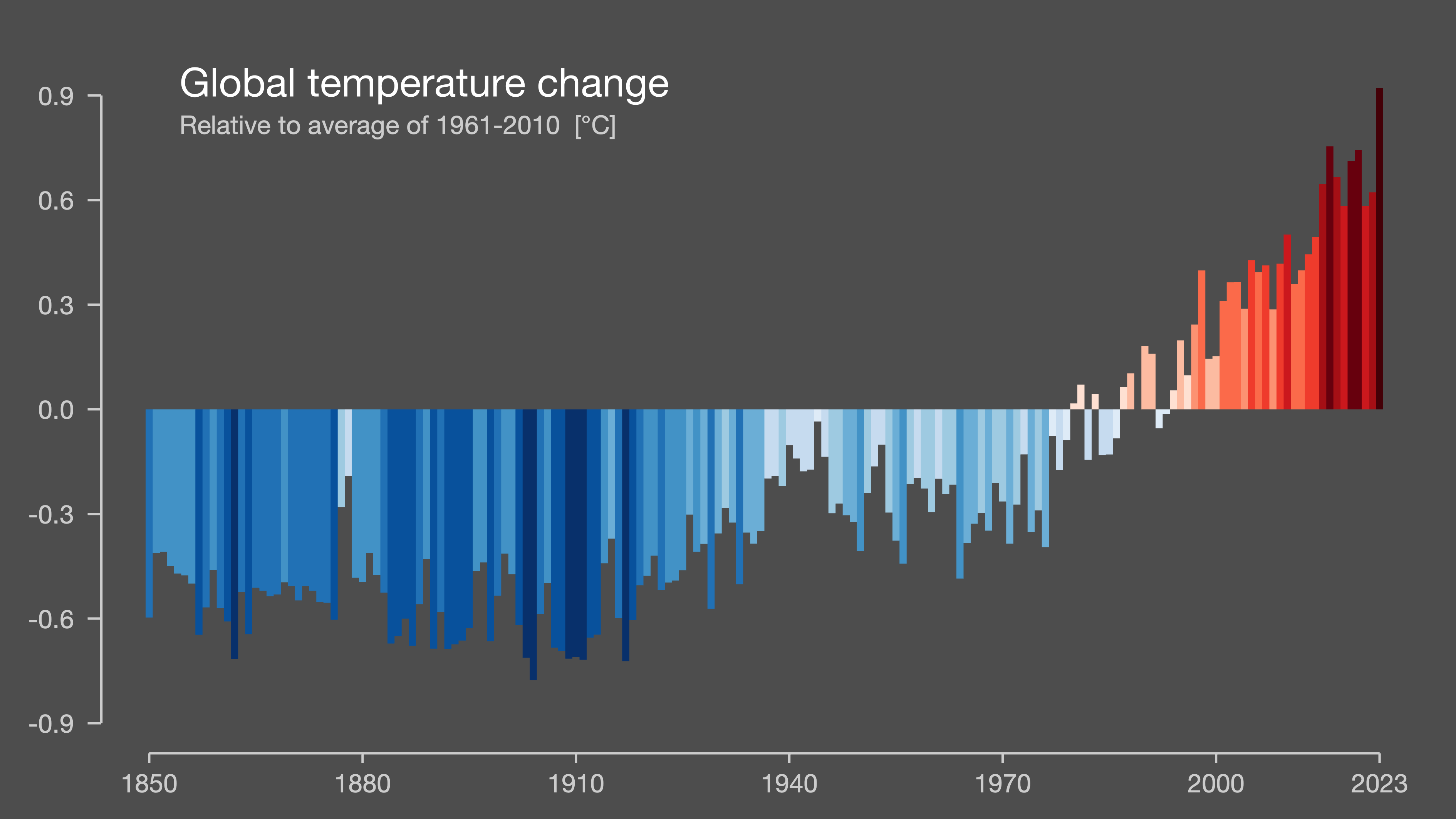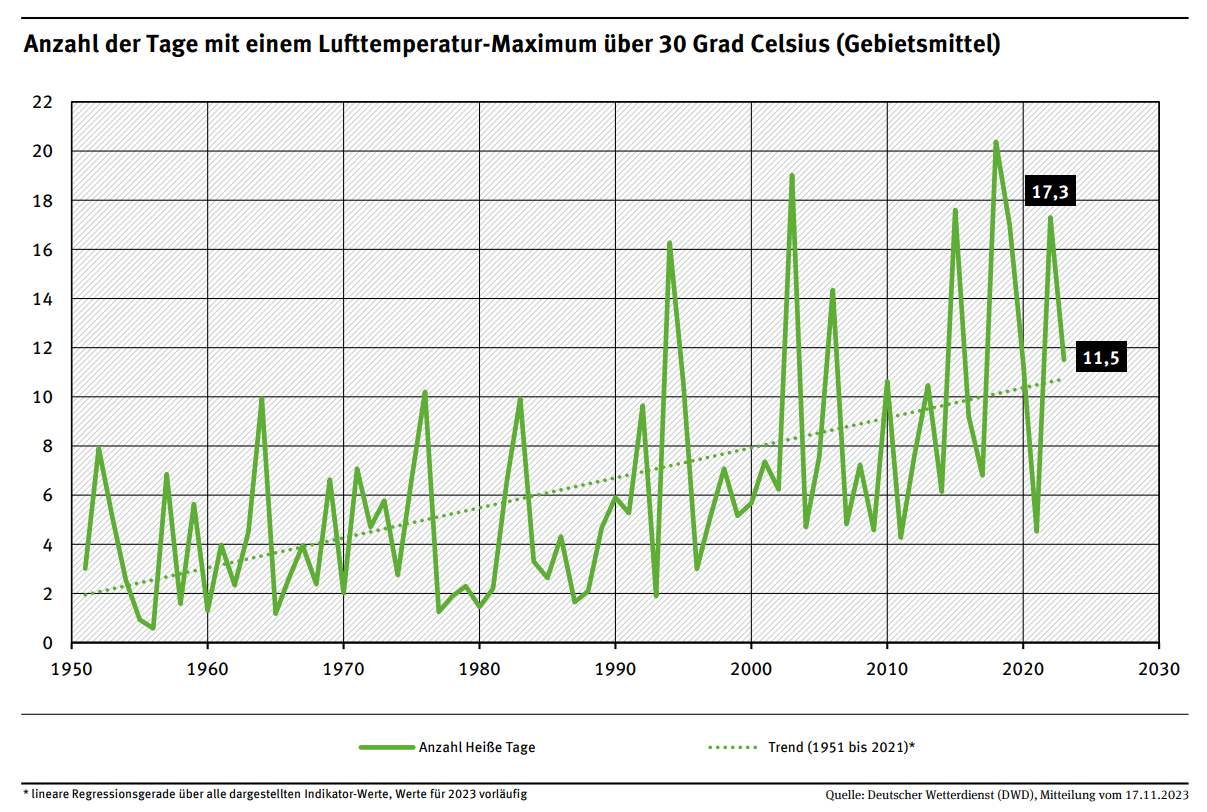Heat
Summer days with temperatures of more than 25°C are considered to be part of a pleasant summer by many. However, when high temperatures persist for a long time and it does not cool down at night, heat can quickly become a burden for many areas of social life. Therefore we provide an overview of the natural hazard of heat on this topic page, on the influence of climate change on this extreme weather and the challenges it poses for German civil protection.
© Pixabay
Heat waves in Germany
„A heat wave is a period of several days with unusually high thermal stress. A heatwave is an extreme event that can damage human health, ecosystems and infrastructure” (DWD 2021).“
In Europe, heat waves are usually triggered by strong and almost stationary areas of high pressure, which are usually located above Eastern Europe or Scandinavia and combine with an Azores high. Warm air masses can move from North Africa to Central Europe as a result of this weather situation. Distinct high-pressure areas can also divert low-pressure areas with high precipitation away and thus prevent cooling (DKKV 2019, p.3). Heat waves are “creeping” natural hazards, as heat is more far-reaching in its temporal and spatial extent than, for example, a heavy rain event, which usually lasts only a few hours and extends over a comparatively small area. Compared to a heavy rain event, which is very difficult to predict, heat waves also take longer to announce themselves.
If greenhouse gas emissions continue to rise as they have in the past and climate change continues unchanged as a result, scientists predict that heat waves will increase in frequency and intensity in the future. The development trend towards a higher average global temperature is visualised in Figure 1, which shows the temperature values for the years 1850 – 2017.
Warming Stripes by Ed Hawkins
British climate researcher Ed Hawkins converted the temperature deviation from the average value of the past decades into coloured lines – dark blue symbolises “very cool” and dark red “very hot” (see Fig. 1). It can be seen that the “hot” years have increased strongly in the recent past. This trend is also measurable in Germany. Since 1881, a long-term temperature increase of 1.7°C in summer has been recorded in Germany (UBA 2023). A particularly strong increase in average temperature has been evident for a few decades; for example, the warmest decade since beginning of the evaluation was the decade from 2011-2020 (Imbery et al. 2021). The hottest measured temperatures in Germany were recorded in North Rhine-Westphalia in both 2019 and 2020 with 41.2 degrees Celius (DWD 2020).
Table 1: Warming Stripes by Ed Hawkins. Representation of the global average temperature of the years 1850 – 2023 (University of Reading).
Table 2: Number of days with an air temperature maximum above 30 degrees Celsius (UBA 2023)
Effects of Heat Waves
The effects of heat waves can be manifold. Extreme heat tends to result in indirect rather than direct impacts for the population. Direct impacts occur, for example, during a heavy rain event when property is destroyed by flooded basements.
Direct impacts of a heat wave affect people’s health. The health consequences of heat waves are diverse and primarily affect vulnerable population groups such as the elderly, children or physically impaired people with chronic diseases. If direct sunlight on humans lasts for a longer period of time and no head protection is worn, meninges and brain tissue can be harmed (Niederer 2019). The resulting symptoms of dizziness, headache and nausea are also known as “sunstroke”. Further exposure to the sun can lead to an overload of the body’s cooling system. A “heat stroke” is triggered in which the brain swells strongly. Without direct medical help, this can lead to permanent damage to the nervous system and even death (ibid.).
Heat deaths in Germany
The Global Climate Risk Index 2020 states that due to the extreme heat wave in the summer of 2018, Germany was one of the countries most affected by extreme weather events in the world this year, along with Japan and the Philippines (Germanwatch 2020, p.1). The months of April to July 2018 were the hottest months ever recorded in Germany, with temperatures 2.9°C above average (ibid., p.3). The heatwave led to the deaths of more than 1,000 people. Germany had the third most fatalities due to extreme weather in 2018 compared to the rest of the world (ibid., p.2). The hot and dry summer of 2018 also resulted in 70% of the land being affected by drought in autumn. Due to massive crop failures, emergency government aid of around €1 billion was requested by farmers. More on this topic.
In the context of heat, indirect effects refer, for example, to restrictions for the functionality of infrastructures. Due to the high temperatures, electricity generation in Germany may be limited or public buses and trains may not be able to operate due to a defective or missing air conditioning system (Bach et al. 2015, p.31). In the transport and traffic sector, so-called “blow-ups” can also occur due to the effects of heat. On motorways, this can lead to the introduction of speed limits or complete closure. The airport in Hanover had to be closed for one day due to the heatwave in 2018, as the runway was broken open by the heat. Due to the accompanying lack of precipitation and the higher evaporation caused by the heat, many rivers have low water levels, which can lead to a restriction or suspension of navigation. In addition, temperatures in rivers and lakes are rising steadily, which can have negative ecological consequences such as fish mortality. More information on the topic.
Heat waves are also events that affect municipalities to varying degrees. For example, the “urban heat island effect” can cause much higher temperatures in heavily sealed cities than on the outskirts or in the urban hinterland. Even at night, the temperature can cool only slightly due to the high degree of urban sealing; streets and concrete facades then release the heat stored during the day (Energiezukunft 2020).
German agriculture can also be severely affected by a heat wave and an accompanying drought. However, fruit, cereal and dairy farmers are affected to different degrees: During the extreme heatwave in 2018, the high temperatures and the lack of or insufficient precipitation led to crop harvest losses of 27 per cent across Germany (Leopold 2018). Winegrowers and some fruit farmers, on the other hand, benefit from the intense heat, as it enables an early and larger harvest (ibid.).
Heat waves and drought also affect German forests. Drought years and water shortages can endanger the forest stand in the Federal Republic of Germany, as they trigger drought stress in the trees. Drought also increases the risk of forest fires. In the extremely hot year 2018, for example, 2,349 hectares of forest were destroyed by forest fires. In comparison, just under 400 hectares were affected by forest fires in 2017 (Waldbrandstatistik 2018). More of the effects of droughts can be found here.

© Pixabay
Measures during heat waves
Heat waves pose health risks that should not be underestimated and can even have fatal consequences. Citizens should therefore be aware of adaptation measures so that they can survive the high temperatures as healthily as possible. For example, in order to protect the body’s cooling systems during a heat wave and to be able to adapt to the high temperatures, people should stay in cool rooms as much as possible, drink plenty of fluids and avoid physical exertion. The BBK has formulated various measures for personal precaution. But is personal precaution enough to create a resilient society with regard to future extreme heat waves?
Political framework for adaptation to heat waves
In June 2023, the Federal Ministry of Health presented a new project: the creation of a National Heat Protection Plan, which is to be valid nationwide according to the French model. This is intended in particular to better coordinate and enable warning systems and the protection of vulnerable groups.
In order to strengthen German civil protection, political framework conditions for climate adaptation have been created at the federal level. In December 2008, for example, Bundeskabinett (Federal Cabinet) adopted the “German Strategy for Adaptation to Climate Change” (DAS) and in April 2023 the draft Climate Adaptation Act. These create a framework for national adaptation, “in which the risks are identified step by step with the Länder and social groups, the possible need for action is named, the corresponding goals are defined and possible adaptation measures are developed and implemented” (KAnG 2023). The DAS is intended to reduce the vulnerability of societal and economic systems to the impacts of climate change and at the same time increase the resilience of the Federal Republic. In addition to the DAS, the Adaptation Action Plan (APA) was developed in close cooperation between the federal government and the Länder. This plan sets out how the options for action presented in the DAS can be implemented through concrete activities of the federal government and projects in cooperation with the Länder. Through this plan, federal measures can be prioritised on the basis of current climate information and an overview of current federal and state activities can be created. In addition, the DAS is regularly adapted to the current state of knowledge through progress and monitoring reports (UBA 2022).
In response to the political framework for action created by the DAS and the APA, the strategic alliance of authorities “Adaptation to Climate Change” was founded in Germany. Consisting of BBK, the “Bundesinstitut für Bau-, Stadt-, und Raumforschung” (Federal Institute for Research on Building, Urban Affairs and Spatial Development), DWD, THW and the Federal Environment Agency (UBA), the purpose of this cooperation is to create an interdepartmental exchange of knowledge on climate change issues relevant to population protection.
Heat action plans
In order to minimise the risk from heat, heat action plans can be drawn up as a preventive measure. These “[…] pursue an integrative approach that combines short-, medium- and long-term health protection measures in a common framework” (Bundesministerium für Gesundheit 2020). A working group of the Federal Government and the Länder developed recommendations for action for municipalities in 2017. The recommendations for action are based on eight core elements, which include interdisciplinary cooperation or the use of the heat warning system from the DWD, as well as the preparation of health systems and special attention to risk groups (Heinze 2020). Based on these core elements, the Länder are to take on a coordinating role and support the municipalities in developing heat action plans tailored to the respective region. The aim of such plans is to reduce the heat exposure of citizens through preventive measures and to avoid heat-related illnesses and deaths.
Individual Measures
The Federal Office of Civil Protection and Disaster Assistance (BBK) recommends the following measures, among others:
- Drink enough fluids (at least 2-3 litres a day). Mineral water or diluted fruit juices are suitable. Avoid caffeinated drinks and alcohol. Make sure you have enough drinks in stock.
- Eat salty foods to cover mineral loss.
- Only exercise in the early hours of the morning or in the evening.
- Avoid physical exertion in direct sunlight.
- Wear loose-fitting and light-coloured clothing.
- Wear a light head covering when outdoors to protect yourself from direct sunlight. Children should not be in the sun for long periods of time.
- Seek shade.
- Use water sparingly
Pay attention to your fellow human beings and, if necessary, vulnerable people around you!
Heat Warning System of DWD (German Weather Service)
In its heat warning system, DWD defines a heat wave on the basis of the perceived temperature around midday, indoor conditions during the night and people’s temporal adaptation to heat. Warnings apply in each case for the current and next day for different altitude levels in the respective counties.
More information
- heat flyer of the BBK
- Advisor – Climate Change and Health: Information on health effects of summer heat, heat waves and tips for preventive health protection (UBA, DWD)
- Health risks due to heat (UBA)
- DWD Heat Warnings – Newsletter (DWD)
- Heat etiquette (UBA)
- Health consequences of climate change (BZgA)
- Recommendations for the preparation of heat action plans to protect human health (BMUV)
- Weekly report on heat-related mortality (RKI)
Emergency Apps
- NINA – Emergency Information and News App: NINA warns of dangers, such as floods and other major emergencies, throughout Germany and, if necessary, on a location-specific basis.
- With the DWD’s WarnWetter app you are always up to date, even when you are on the move. The free app from the DWD provides emergency services and the general public with important information on the current warning and weather situation.
- The umweltinfoApp of the Bavarian State Ministry for the Environment and Consumer Protection informs and warns Bavarian citizens about selected environmental hazards in real time and in relation to specific locations. During a heat wave, information on ozone levels, the UV index and the risk of forest fires are of particular interest.
created: June 2023
Current Information
Hottest June in Western Europe: heat-related deaths due to climate change
A new study shows that the number of heat-related deaths in Europe has tripled due to climate change. June 2025 was the hottest June in Western Europe since weather records began. The average temperature was 2.81 degrees above the average value from 1991 to 2020. Two...
Warning of heatwave with almost 40 degrees in Germany
Germany is facing an intense heatwave in the coming days, peaking on Wednesday, with temperatures of up to 39 degrees and tropical nights of over 20 degrees, according to the German weather service. In addition to the high heat load, the risk of forest fires is also...
Extreme heat in cities: New UN resource package to support cities
The number and intensity of heatwaves in cities is increasing worldwide - with sometimes dramatic consequences for health, infrastructure and the environment. In order to better prepare cities for this growing challenge, the UN initiative Making Cities Resilient 2030...







